What are tungstates in mineralogy ?
Tungstates : definition
Tungstates make up a minor subclass belonging to the large mineralogical class of "sulfates, chromates, molybdates and tungstates", whose structure is built from tetrahedra (WO4)2- assembled by cations.
The minerals of the subclass of tungstates are about ten in number and belong mainly to two isostructural groups : the group of wolframite (Fe,Mn)WO4 and that of scheelite CaWO4, the two essential ores of tungsten.
Tungsten and molybdenum have similar ionic radii and are therefore very easily replaced in tetrahedrons. Therefore, there are partial solid solutions between scheelite (CaWO4) and powellite (CaMoO4) on the one hand, and between stolzite (PbWO4) and wulfenite (PbMoWO4) on the other hand. As lead and calcium are also substituted, partial "transverse" scheelite-stolzite and powellite-wulfenite solid solutions are observed.
The minerals of the subclass of tungstates are about ten in number and belong mainly to two isostructural groups : the group of wolframite (Fe,Mn)WO4 and that of scheelite CaWO4, the two essential ores of tungsten.
Tungsten and molybdenum have similar ionic radii and are therefore very easily replaced in tetrahedrons. Therefore, there are partial solid solutions between scheelite (CaWO4) and powellite (CaMoO4) on the one hand, and between stolzite (PbWO4) and wulfenite (PbMoWO4) on the other hand. As lead and calcium are also substituted, partial "transverse" scheelite-stolzite and powellite-wulfenite solid solutions are observed.



